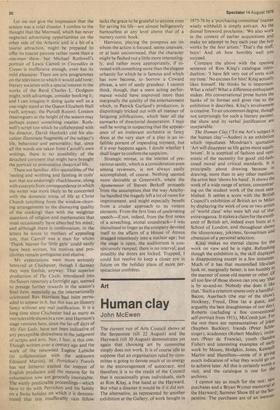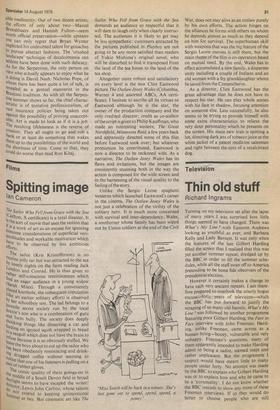Art
Human clay
John McEwen
The current run of Arts Council shows at the Serpentine (till 22 August) and the Hayward (till 30 August) demonstrates yet again that choosing art by committee simply does not work. It is of course idle to suppose that an organisation ruled by committee is going to devote much of its energy to the encouragement of autocracy, and therefore it is to the credit of the Council that it occasionally gives individuals, such as Ron Kitaj, a free hand at the Hayward. But what a disaster it would be if it did not. The alternative, as represented by another exhibition at the Gallery, of work bought in 1975-76 by a 'purchasing committee' (names wisely withheld) is simply anti-art. As the dismal foreword proclaims: 'We also work in the context of earlier acquisitions and make no attempt to buy each year the best works by the best artists.' That's the stuff. boys! And oh how horribly well you succeed.
Compare the above with the opening sentence of Ron Kitaj's catalogue introduction: 'I have felt very out of sorts with my time.' No excuses for him! Kitaj actuallY likes himself. He thinks he is important. What a relief! What a difference enthusiasm makes. His conversational prose bursts the banks of its format and gives rise to the exhibition it describes. Kitaj's involvement is creative. To an uncommon degree, though not surprisingly for such a literary painter. the show and its verbal justification are inseparable.
The Human Clay, ('To me Art's subject is the human clay'—Auden) is an exhibition which repudiates Mondrian's quotation 'Art will disappear as life gains more equilibrium'. It is sceptical of fashion and optimistic of the necessity for good old-fashioned moral and critical standards. It principally about drawing because m drawing, more than in any other medium. the artist best 'shows his hand'. It shows the work of a wide range of artists, concentrating on the student work of the most established. It settles a score with the British Council's exhibition of British art in Milan by displaying the work of one or two artists of 'world class' who were left out of that extravaganza. It stakes a claim for the excellence of British art, indeed even hints at a School of London, and throughout shows the idiosyncrasy, jokiness, favouritism and obsession of a personal selection. Kitaj makes no eternal claims for the work on view and he is right. Refreshing though the exhibition is, the skill displayed is disappointing except in a few instances. Much of it has that mummified life-class look or, marginally better, is too humbly in the manner of some old master or other. Of all too few of those shown can you say 'that is by so-and-so. Nobody else does it like that.' Such a criterion spares only a handful. Bacon, Auerbach (the star of the show). Hockney, Freud, Dine (as a guest, and arguably the best draughtsman of our daY). Roberts (including a fine conventional self-portrait from 1911), McComb just. for the rest there are representatives of jokes (Stephen Buckley), friends (Peter Schlesinger), academics (Robert Medley), imitators (Peter de Francia), youth (Sandra Fisher) and interesting examples of earlY work by Moore, Hodgkin, Jones, Kenneth Martin and Hamilton—none of it giving much indication of what they would go Oa to achieve later. All this is certainly worth 3 visit, and the catalogue is one for the archives.
I cannot say as much for the rest purchases and a Bryan Wynter memorial at the Hayward; Summer Show III at the Serpentine. The purchases are of an inexcus able mediocrity. Out of two dozen artists. the efforts of only about two—Marcel Broodthaers and Hamish Fulton—seem Worth official preservation—while upstairs one can only regret that Bryan Wynter neglected his undoubted talent for gouaches to pursue abstract fashions. The 'crushed landscape' technique of decalcomania can seldom have been done with such delicacy. As for the Serpentine, the only person on View who actually appears to enjoy what he IS doing is David Nash. Nicholas Pope, of Whom there has been quite a lot of talk, is revealed as a genteel mannerist in the Brancusi tradition. As with all the Serpentine summer shows so far, the chief characteristic is of tentative professionalism, of vast insurance policies being taken out against the possibility of proving unacceptable. Art is made to look as if it is a job. The resulting lifelessness is the reverse of creation. They all ought to go and rob a bank or at least do something that wakes Mein up to the possibilities of the world and the shortness of time. Come to that, they could do worse than read Ron Kitaj.



























 Previous page
Previous page